‘Give me one kiss in apple blossom …‘ (Kate Bush, Oh England My Lionheart)
Hello lovely readers and a happy new moon in Aries!
This new moon is rather special as it’s the second in a row in Aries, and also a solar eclipse. From what I read, it’s a time of great cosmic change and possibility. We’re advised to be brave, to take a leap of faith, to believe that ultimately there’s a net to catch us. If we don’t forge ahead we will never know what we’re capable of. In a way, I suppose, a bit like the tiny moon being capable of eclipsing the light of the sun when it passes in front of the flaming giant.
As we approach May’s Eve, nature expresses that perfectly with the burgeoning of the cow parsley, alexanders, nettles and alkanet in every wild edge-place. Not to mention the exuberent bleats of the tiny lambs along the lane. There’s no doubt that life in every form is thrusting forth with perfect confidence. As it should. And I can’t think of a time of year when it feels more thrilling to be alive.
Lambs along the lane, April 2023.
The two men in the road were taken aback.
The lovers came out shading their eyes from the sun,
And never was white so white, or black so black,
As her cheeks and hair. ‘There are more things than
one
A man might turn into a wood for, Jack,’
Said George; Jack whispered: ‘He has not got a
gun.
It’s a bit too much of a good thing, I say.
They are going the other road, look. And see her
run’ -
She ran. - ‘What a thing it is, this picking may!’
Edward Thomas, Lovers
Rowan Dance
Rowan twigs and red thread
Keep the witches from their speed.
(Traditional)
To impart a potent protection on the home for the year, branches of the Rowan are to be hung over doorways on May morning … tied with red thread … small bound crosses of Rowan may be carried as pocket charms or hung within the home at the portal points … these charms are to be installed on May’s Eve and Hallows’ Eve, two of the three ‘spirit nights’ of the year, ‘to keep faeries and black witches at bay’.
Gemma Gary, The Black Toad
That the Rowan is a tree of protection is widely known, as are the folk practices and rhymes involving rowan twigs and red thread. And May’s Eve is one of the traditional times to harness this most useful of attributes.
But Rowan brims over with magic in so many other ways.
In Greek legend Hebe, the daughter of Zeus and Hera, was cup bearer to the gods and daily filled their goblets with sweet nectar. Then she let her duties slip and Zeus’s cup was stolen by demons. This caused great concern amongst the gods, and they sent a special eagle to deal with the demons and recover the cup. A fierce battle ensued. But despite the horror, wherever an eagle’s feather or a drop of blood fell, there grew a rowan. And this is why, to this day, the rowan has feathery leaves and berries like drops of blood.
DRAGON FIRE
In Irish myth, the berries of a certain magical rowan had the power to sustain people as though they had had nine meals. This tree was guarded by a particularly strong dragon - and it is this link between dragons and rowans and hills that seems so interesting.
I conjure thee O Serpent Red / coiled in the land …
Gemma Gary, Traditional Witchcraft: A Cornish Book of Ways
You will often see a tree on a hillside and find that it’s a rowan, silvery roots snaking into thin earth. Irish legend is full of accounts of dragons and serpents guarding rowans. Perhaps we could turn that around and suggest that the lone rowan on the hill actually guards the dragon or serpent that, in so many traditions, is coiled in the land. The two are interchangeable it seems, and here in Norfolk our own Ludham Dragon is also known as the Ludham Wyrm.
In Tree Wisdom Jacqueline Memory Paterson tells us that spirals are the most common symbol of this earth dragon, for dragons were believed to coil themselves around hills. It followed that hills could be formed by dragons squeezing their coils upon the landscape, making the earth rise. This was borne out by hills that actually bear such coil marks, including Wormington (Wyrm-ington) Hill in Gloucestershire and Glastonbury Tor.
Rowan dances for May’s Eve, and dances on a hill, where the wind whisks and summer rushes in, blown by the roar of dragon fire.
Bunting flag dyed with rowan and embroidered with the constellation Draco the dragon, flying from a rowan tree in Crow Wood.
FINDING THE PLACE
Once I locate the find spot on the map it’s easy to track down. And then, of course, I just have to pack up a flask and get going.
Pulling onto the rutted track next to the medieval round towered church, I slip down from the van. Then, map in hand and grinning to myself with the adventure of it all, I set off down the lane towards the gap in the hedge I predict will be there. Yes! Just as I’d hoped, there’s a battered wooden ‘public footpath’ sign. I double check the map in my hand, and realise with excitement that this path will lead me directly to the place. Almost a literal cross on a treasure map.
The verge between hedge and newly-sprouted field is high and narrow and the mud hard as baked clay skirt the farmhouse, and stepping between awakening hawthorns I find myself on the edge of the field. On the far side of this field, in 1972, a perfect, intact, Bronze Age beaker was unearthed for the first time in perhaps 4,000 years. And the form of the vessel for my Rowan Dance candle was inspired by this beaker, found in the very parish in which my own cottage lies.
Charles Owles with the Bronze Age Beaker excavated on his land, 1972.
The sweet scent in my nostrils turns out to be alexanders, which I’ve read somewhere is the county flower of Norfolk. Not surprising really, since it seems to line every hedge bank. It’s said to have been brought over as food by the Romans, and with a start I realise that the Bronze Age people who lived here would not have seen or smelled it.
WILD CELEBRATION
This beaker is thought to be one of the earliest examples from Norfolk, the homely cord and fingernails pressed into its surface giving a tiny but touching glimpse of its maker. A treasured possession. They are often the only surviving artefacts found in their owners’ graves. I imagine hands clasped around the vessel with love and care on joyous community occasions.
Glancing across to where the bare hawthorn twigs are just starting to show green, I think about the bursting forth of the may. Then, as now. And wouldn’t THAT be a cause for wild celebration?
Rowan Dance candle on the field gate.
To decorate the Rowan Dance pot I decided on an Anglo-Saxon stamp that looks like a backwards S, and asked David the Potter to space the marks unevenly in a loose band. In this way they echo the intimacy of the all-over markings on the Bronze Age beaker, which were created by the touch of twisted cord and human finger nail. Of course, the idea of an Anglo-Saxon symbol on a Bronze Age vessel is wildly anachronistic, but I always knew that the inspiration for the candles’ stories could flutter in from anywhere in this world or beyond.
I chose the ‘S’ stamp because I had read somewhere that it might represent a Wyrm, a link to the serpent and dragon imagery snaking through Rowan Dance’s tale. But when I searched again I could find nothing useful at all. It was astounding to realise that so little work has been done on interpreting these stamps. It’s easy to find them classified by type (the ‘Wyrm’ is part of Class H in the Stamp Archive), but very few researchers appear to have gone further than that.
Excitingly, though, I also discovered a theory* that the inscribed Wyrm on some urns may be a reference to the god Thunor, representing his sun-wheel as well as the fiery dragon. If this is right, it fits our purpose very well.
Thunor is the Anglo-Saxon equivalent of the Norse god Thor. And Thor was saved from being swept into the Underworld by a powerful river when a tree leaned over so that he could grab its branches.
That tree was a rowan.
Cuckoo Spells
The cuckoo is a fairy bird, and sings in time to the heartbeat of the Earth. She is herald of the spring, and ushers in its spirit. She is a bird of the goddess, and as she brings in the bounty of the springtime, so must her blessings also demand their proper sacrifice; and so her progeny are laid as gifts in other birds’ nests.
Old wives who know in their souls that the cuckoo is a bird of the goddess say that she turns into a hawk in winter, for their wisdom tells them that the goddess is the giver and taker of life. When she gives life, she is the cuckoo of the spring and early summer. When she takes life, she is a hawk of the grim winter.
Old wives say too that her spirit enters into the underground fairy halls to pass the winter, although her creature form flies to the summerlands.
Claire Nahmad, Earth Magic
In Earth Magic, Claire Nahmad tells us that in parts of Cornwall, the Cuckoo Feast is still celebrated on the Sunday closest to 28 April to commemorate the day on which this magical bird ‘ushers in the spirit of the spring’.
The story goes that one evening in April, when the weather was bitterly cold as if it were still the depths of winter, a farmer invited some friends to share his hearth, throwing a great hollow log upon the fire to keep it blazing for their comfort. A cuckoo flew out of the hollow log and, from that moment, the weather altered, turning warm and bringing in the soft airs of spring.
In fact, the cuckoo was once associated with country fairs throughout the land, notably the one at Heathfield in Sussex which was traditionally held on ‘Cuckoo Day’, 14 April. The highlight of the Heffle Cuckoo Fair is the moment that the Old Woman, who is said to control the seasons ‘releases cuckoos aplenty if she is in an amiable mood, but only a few if human beings have raised her anger; she therefore confers her blessings either abundantly or frugally’.
It all makes sense, except that 14 April is early for cuckoos returning to the UK, even in Sussex which is about as far south as you can get. Of course, before the Julian Calendar was superseded in 1752 and 13 days lost, the same prevailing seasonal conditions would have been found 13 days later. In other words, the seasonal conditions of around 27 April today. The date of the Heffle Cuckoo Fair was never adjusted to allow for this. Finding the real thing in short supply, we hear in Maypoles, Martyrs and Mayhem, ‘Dame Heffle’ would actually release a homing pigeon from her bag, a hidden tape recorder filling the air with the notes of the cuckoo, the very sound of the spring.
I understand that the Fair has been suspended for the time being, the last one recorded on their Facebook page dating from 2019. Somehow I have a feeling that the contemporary event is likely to have been a less rumbustious affair than the original medieval spectacle that began in 1315 when the Bishop of Chichester obtained permission to hold a weekly market and an annual fair.
As Claire Nahmad observes, this custom seems linked to the idea of a winter/spring goddess, and Jacqueline Durban who writes Radical Honey on Substack came independently to a similar conclusion, feeling that the Old Woman could readily be associated with winter hags such as the Cailleach of Gaelic Scottish and Irish lore. The word Cailleach derives from Caillech, a term meaning ‘veiled one’ in Old Gaelic, and this fits well with the image of the winter allowing spring to fly forth with the wings of a cuckoo.
A little research reveals that the Heffle Fair is by no means the only regional custom to put the cuckoo on a pedestal, crediting its arrival with the onset of good weather. Often the traditional dates are a nod to the Old Calendar, being held towards the end of the month.
During the Cuckoo Fair at Downton in Wiltshire, the highlight is the ‘opening of the gate’ to let the cuckoo through. Downton fairs are first recorded in 1249, and in 1289 a fair was claimed on the ‘eve, day and morrow of St. Laurence’, 9 - 11 April. Early fairs died out, but in 1676 two annual fairs were granted on 12 April and 21 September. Although these were mainly for livestock trading, the spring fair at some point became known as the Cuckoo Fair (I would guess, before 1752). The date of this year’s event is 29 April, so it looks as if this community, like others, has seen merit in delaying the festivities to stay in step with nature and the Old Calendar.
I had not intended to return so soon to the teachings of our Yorkshire wisewoman we last met in The Sun’s Dance. But as April is, after all, known as the Month of the Cuckoo, I couldn’t resist sharing with you some of the fascinating snippets of cuckoo lore imparted on her behalf by her granddaughter Claire.
Count the cuckoo’s notes when you first hear them in the spring; as is their number, so do they indicate the number of years which must pass before a maiden is to be married; and if there are very many, the divining maid need not despair, for in that case she must count them as months.
Good luck is with you if you hear the cuckoo call on 28 April. If you first hear her soft notes on 6 April she warns you to be cautious in your endeavours. If you hear her calling on your right she sings to you that all is well; to your left, she urges you to beware.
If you first hear the cuckoo when walking on lush grass or the fragrant soil of a woodland, that is good, but if you stand on harsh, stony, barren ground or on the surface of a lane or a road you must say: Cuckoo spirit fly hither / Chase evil luck thither.
If you have money in your pocket when you hear the cuckoo call, turn it over at once and speak this charm: Lucky coins, now I count thee / Cuckoo-fairy bring me bounty. Then, when you are still touching the coins, make a wish and it is bound to come true.
When the cuckoo calls through the woods bright and early in the spring, a lovely long warm summer is forecast; and if the cuckoo should call more than 21 times all at once, that is a sure sign of coming rain, warm and genial, showering upon the earth to bing forth the flowers and pretty grasses of spring and to coax the buds to burst on the trees.
Please let me know in the comments when you first hear the cuckoo - if you do at all, as sadly their call is much rarer than it was - and I will do the same. There have been some years recently when I’ve gone a whole summer without hearing it, but the past couple of years I have, and nearly always from my own kitchen or front yard :)
The Cuckoo’s Revel Buns
I may have been a strange 18-year-old, as I clearly remember being given two cookery books for my birthday that year. One, I think, was called Picnic Basket and it was about making your own baked goods and preserves of all kinds. Possibly growing food, too: The Good Life on TV had really started something. The other, which I still had until relatively recently when it literally fell apart from overuse, was Christmas and Festive Day Recipes by Sara Paston-Williams.
Even at that age I loved the ritual involved in creating food memories that were special to each time of year and although I certainly didn’t try every recipe in the book, I did come back to the same ones year after year. In fact, it was probably from this book that I learned of the culinary traditions around festivals like Michaelmas, All Souls’ Day, Twelfth Night and Mothering Sunday.
Probably the most-used recipe in the whole book was that for Revel Buns. These were rich yeasted buns, perfect celebratory fare for many a medieval saints’ feast day and as they contained saffron and clotted cream they probably originated in Cornwall or the West Country. I’m almost certain that the recipe was given in the May Day chapter and I always made them in the days of the Cuckoo.
If you can find the book I highly recommend the recipe but as I tend not to bake with butter and cream these days I wanted to find a way of making celebratory buns in a different way and start a new Bracken & Wrack tradition.
When I saw a Deliciously Ella recipe for cardamom buns I knew I could adapt it to what I had been looking for. The way the strips of dough were twisted and then wrapped around each other immediately put me in mind of maypole ribbons!
I’m giving the recipe a little before May’s Eve to give you time to gather the ingredients and have a little practice, but please rest assured that there is no wrong way of making the shapes. Just twist the dough however you like and the result will still be wonderful! If you’re not vegan you can spread them with butter, which would be lovely, but in any case warm from the oven they’re certainly a fitting tribute to the Fairy King and Queen of the May. And who knows, maybe you’ll hear the faint echo of cuckoo-call over the greening trees.
250g spelt flour
250g strong white flour
20g coconut sugar
7g fast action dried yeast
0.5 tsp fine sea salt
260ml oat milk
75ml maple syrup
60g coconut oil
2 tsp vanilla paste/extract
Filling: 18g coconut oil, melted
2 tbsp maple syrup
75g coconut sugar
1 tbsp green cardamom pods, seeds removed and ground
Glaze: 3 tbsp maple syrup
Place flours and sugar into a large bowl. Add yeast to one side and salt to the other; mix to combine. In a small saucepan heat the milk, maple syrup, coconut oil and vanilla; leave to cool until lukewarm.
Gradually mix the wet ingredients into the dry until you have a slightly wet rough dough. Turn onto floured surface and knead until elastic and smooth Cover and leave to prove in a warm place for 1 hour until doubled in size.
Make the filling by combining melted coconut oil and maple syrup in a small bowl. In a separate bowl mix together the coconut sugar and ground cardamom seeds.
Flour a surface and roll out the dough to a 40cm x 60cm rectangle. Brush with maple/coconut oil mixture and sprinkle with cardamom sugar.
Fold the dough in half, short sides together and roll again to form a 30cm x 40cm rectangle. Slice into 3cm x 30cm strips. Take one end of a strip, twirl the dough and wrap it around your hand to form a swirl shape, then take the dough around the top and secure the end into the bottom (absolutely no need for perfection here!).
Place the buns on two large baking trays, lined with baking parchment. Cover and leave for 1 hour until almost doubled in size. Preheat oven to 200C/180C fan/390F.
Bake for 20 - 25 minutes until golden brown, then brush with maple syrup. Eat warm or store in an airtight container and enjoy around the maypole or in the greenwood.
Twirled into loose knots and left to rise for a second time. Aren’t they just like maypole ribbons?!
A Spring Walk
It’s quite true (and I have to pinch myself!) that my cottage lies between the heath and the sea. But for an early morning wake-up walk it’s the heath nearly every time, as all I have to do is to wander down the lane, take the narrow track up the hill and there I am.
The word ‘anchoress’ usually refers to a medieval religious calling in which a woman ‘anchored’ herself in a chapel cell and meditated on the holy. I like to think of myself as an anchoress or guardian of the heath, walking its bounds each day and becoming ever more anchored into its being.
Would you like to come along with me?
Let’s take the twisting path through Acorn Wood, up the tree-root steps and out the other side into the lane. How the newborn hawthorn leaves have grown since yesterday! See how white the field is and how the celandines on the verge are fast asleep, waiting for the warming touch of the sun.
We’ll go towards the stream and see how the sea of bluebells under the alders swells day by day. One day soon, an unstoppable blue haze will sweep across its top.
When we reach the little bridge we can scramble down the bank and crouch for a few minutes mesmerised by the flow of the stream and the returning sun, warm on our faces in this sheltered nook. We’ll linger, not wanting to climb back up in case - just in case - a lithe brown otter slips over the little weir and somersaults into the water at exactly this spot. It’s happened twice; well, once definitely and the second time almost so but he was gone quick as a flash while my eye was occupied further upstream.
It’s time to stretch our limbs and make our way back to the cottage. I think you’ll enjoy this part as our path home is through the birches and over the top of the heath, where the low morning rays are melting the frost on the gorse into jewelled droplets. Little rainbows play in my camera lens while muntjacs kick up their heels.
Back on the lane we feel we’ve left an enchanted morning world, but talk of coffee quickens our pace and soon we hear the chirping of sparrows in The Old Shop’s holly hedge and we turn towards the kettle, the calls of great-tit and woodpecker still ringing in our ears.
Alders and the first bluebells close to the stream, 30 April 2022.
A few resources
Claire Nahmad, Earth Magic, Rider 1993
Edward Thomas, Selected Poems, Hutchinson Educational 1962
*Thanks to Prof. Howard Williams (specialist in Anglo-Saxon mortuary practice)
Kate Bush, ‘Oh England My Lionheart’, Lionheart, 1978
Imogen Ashwin, The Old Shop: On May’s Eve, YouTube, 2022
Deliciously Ella (recipe on app)
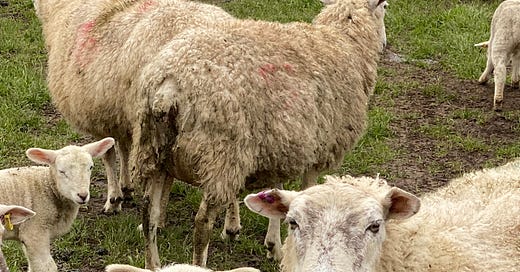




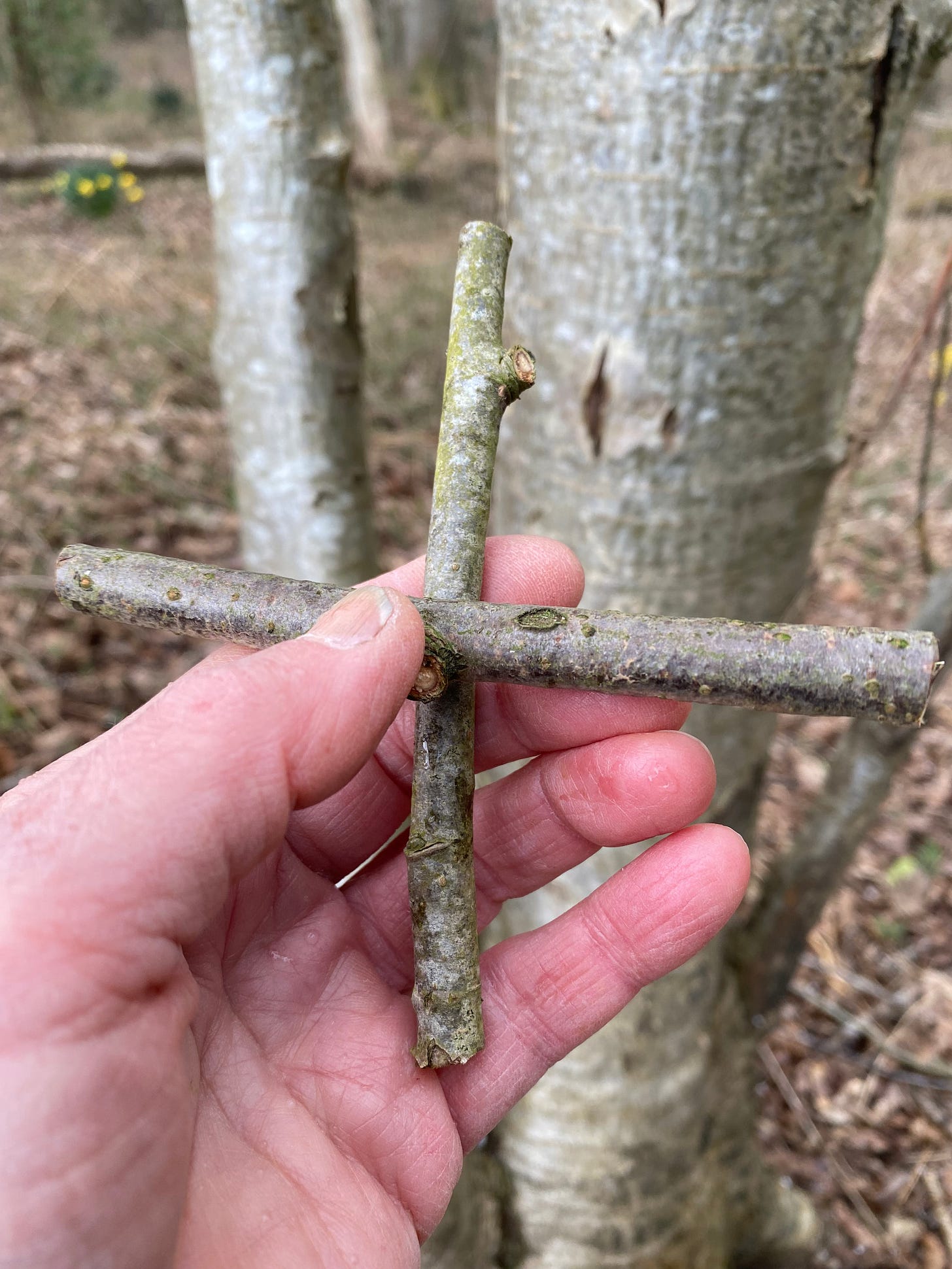

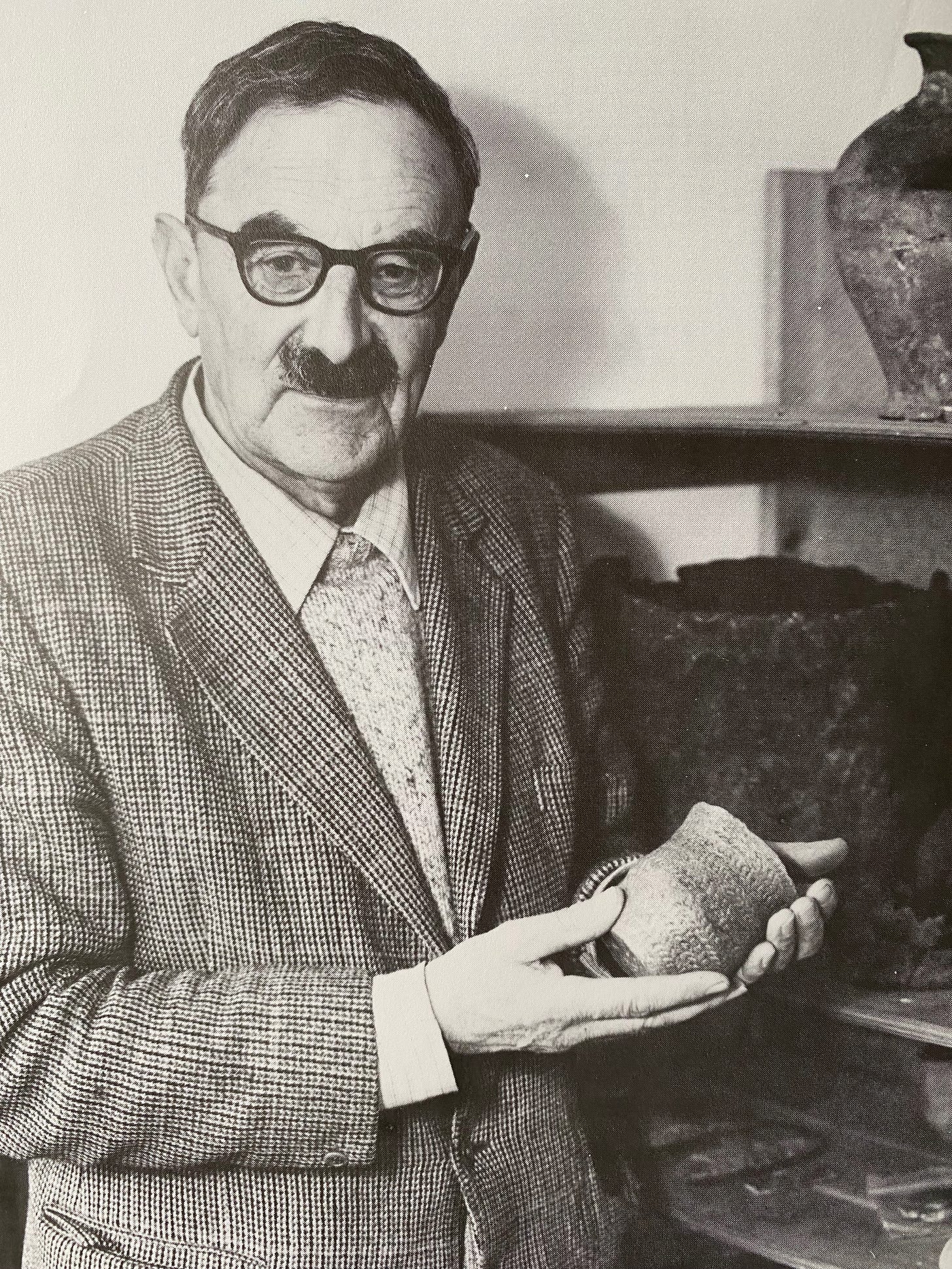
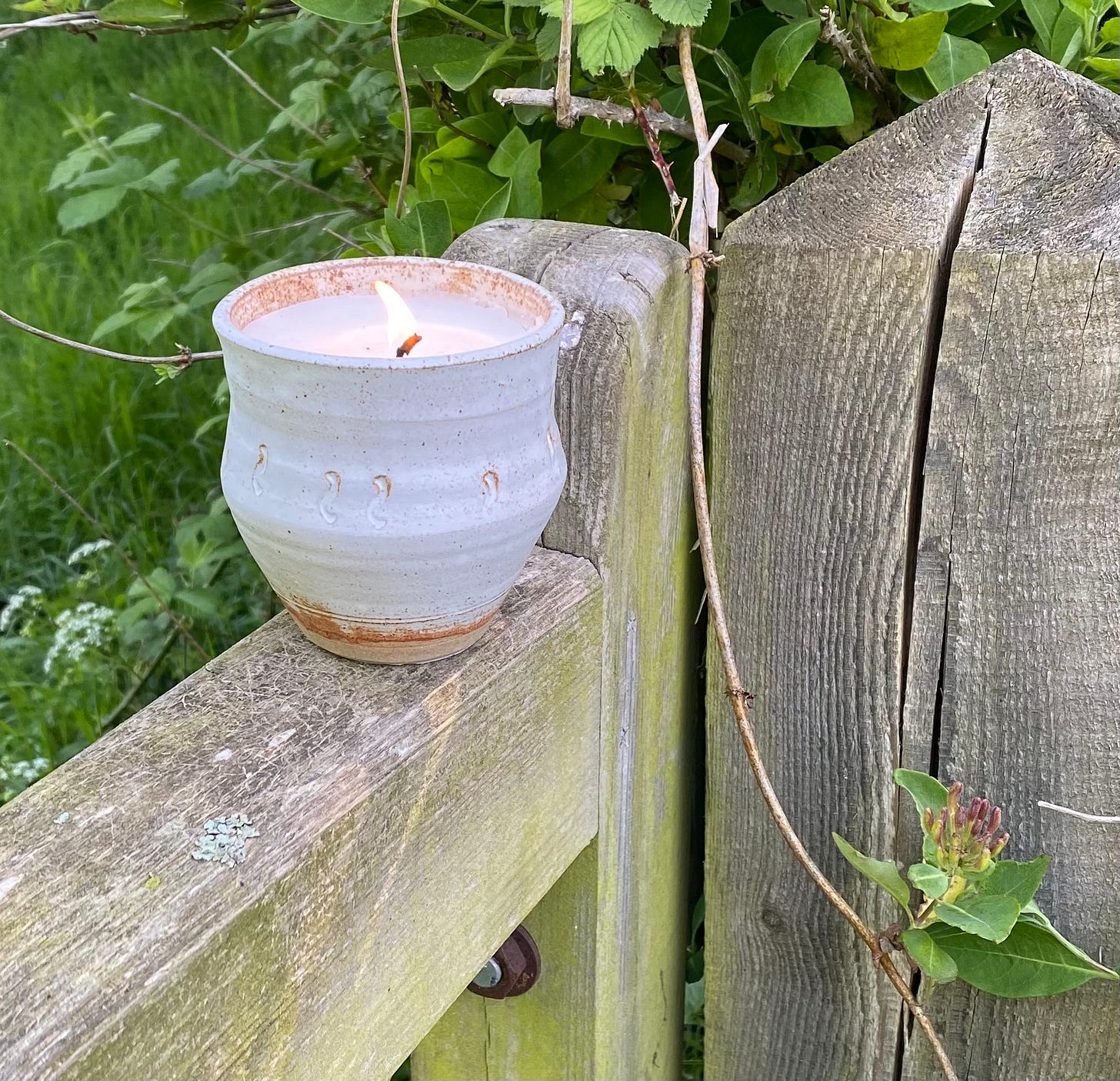
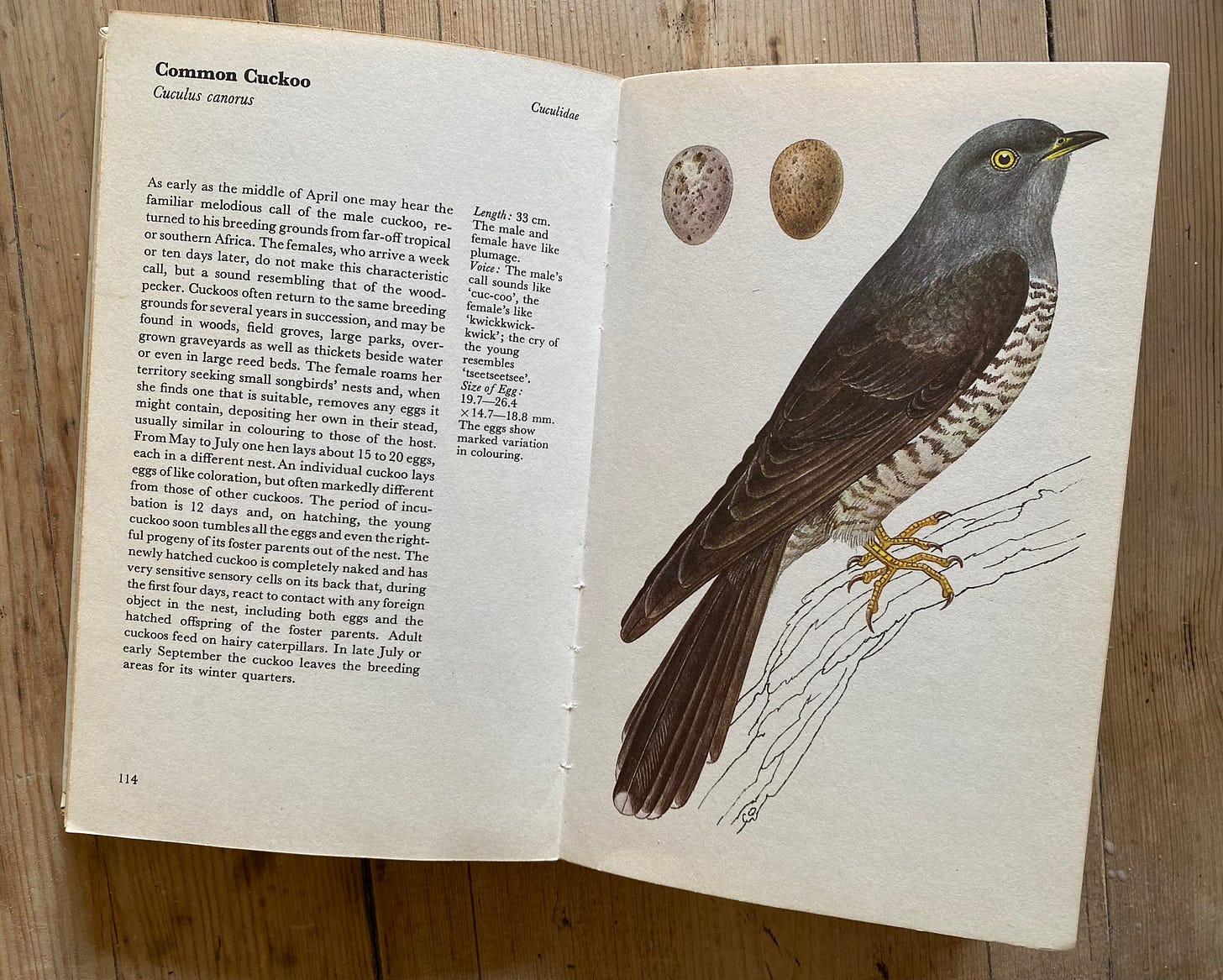


I’m not sure if we have cuckoos here. But there is a bird that flys from New Guinea every spring to lay its eggs in the nests of other birds. It’s called a Koel, and it is in the cuckoo family. It has the most haunting call, early morning. I love it.
https://birdlife.org.au/bird-profiles/eastern-koel/
So many references here I find a kinship with. My pottery mark is a spiral, which I’ve used for decades.
I have a rolling stamp for pottery marking, one of two chosen by my husband, that makes a similar pattern to the Bronze Age beaker.
The Cuckoo festivals. I had to check what cuckoos we have in Canada, as I wasn’t sure I had specifically heard one. We have the black-billed and yellow-billed cuckoo. Would my Cornish DNA recognise the European cuckoo?
Like you, from a young age I had the recipe books and the desire to make food memories from the old celebrations endure.
I am reminded yet again that I must get a copy of Martyrs, Maypoles and Mayhem!
Thank you for the lovely read.